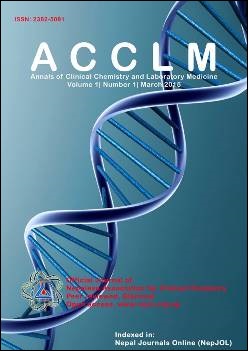Bacteriological and Mycological profile of Chronic Suppurative Otitis Media among patients visiting Dhulikhel Hospital
DOI:
https://doi.org/10.3126/acclm.v1i1.12314Keywords:
Chronic suppurative otitis media, bacteria, fungi, antibioticAbstract
BACKGROUND: Chronic suppurative otitis media (CSOM) is an inflammation of the middle ear and mastoid mucosa with perforation of tympanic membrane. Mainly disease of developing countries like Nepal, CSOM results because of illiteracy, poverty and poor hygiene. Haphazard use of antibiotics and increasing use of newer one has led to persistent change in microbial flora. The aim of this study is to determine the incidence of CSOM and its causative agents.
METHODS: The study included 123 samples from 105 patients attending ENT department of Dhulikhel hospital. Samples were processed in microbiology department for both bacteria and fungi using standard operating protocol. Antibiotic susceptibility testing was performed for all bacterial isolates by Kirby Bauer disc diffusion method and the result were interpreted according to clinical and laboratory standard institute (CLSI) guideline.
RESULTS: Out of 105 patients, 55 were male and 50 female patients. Highest incidence of CSOM was observed between 1-10 years of age group. Of the total 123 samples taken from 105 patients, 106 showed microbial growth. Gram positive bacteria predominated and the most common bacteria isolated were S. aureus 54.55% followed by Proteus spp. 13.64% and P. aeruginosa 12.73%. Among the fungi, the most predominant was A. fumigatus 39% followed by A. niger 29%, C. albicans 26% and A. flavus 6%. Gentamycin was the most susceptible antibiotic. S. aureus were sensitive to Cloxacillin and Gentamycin, whereas Proteus spp. was most sensitive to Ceftriaxone and Norfloxacin. P. aeruginosa was 100% sensitive to Amikacin.
CONCLUSION: S. aureus was the most predominant organism followed by Proteus spp. and the drug of choice was Gentamycin.
DOI: http://dx.doi.org/10.3126/acclm.v1i1.12314
Ann. Clin. Chem. & Lab. Med. 1(1) 2015: 37-41
Downloads
Downloads
Published
How to Cite
Issue
Section
License
Authors who publish with this journal agree to the following terms:
- The author transfers copyright to the Nepalese Association for Clinical Chemistry.
- The journal publishes the work under a Creative Commons Attribution License that allows others to share the work with an acknowledgement of the work's authorship and initial publication in this journal and under the same share-alike license used here.
- Authors are able to enter into separate, additional contractual arrangements for the non-exclusive distribution of the journal's published version of the work (e.g., post it to an institutional repository or publish it in a book), with an acknowledgement of its initial publication in this journal.
- Authors are permitted and encouraged to post their work online (e.g., in institutional repositories or on their website) prior to and during the submission process, as it can lead to productive exchanges, as well as earlier and greater citation of published work (See The Effect of Open Access).




